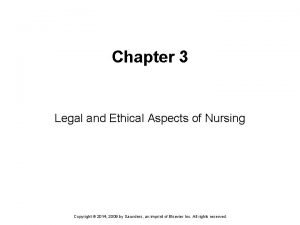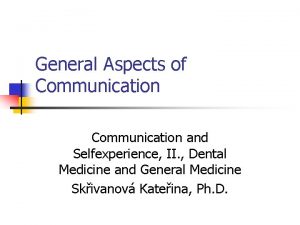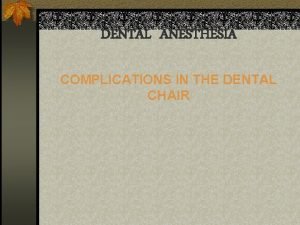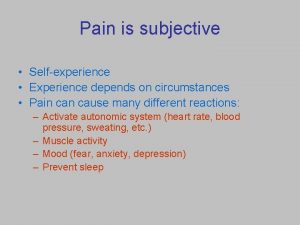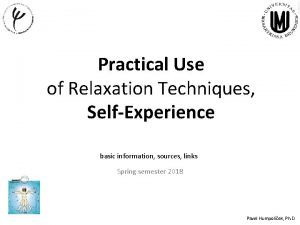General Aspects of Communication and Selfexperience II Dental















- Slides: 15

General Aspects of Communication and Selfexperience, II. , Dental Medicine and General Medicine Skřivanová Kateřina, Ph. D.

Subject of Study of Social Psychology n n n Social psychology is a science on the border of psychology and sociology The subject of social psychology is studying social determination of personality, dyadic relationships, social microstructure (family, study group, work team), social macrostructure (large social groups and institutions) Social determination X personal influence

General Aspects of Communication n n Considered to be an elementary social process by sociologists Communicating meanings (giving, receiving) among people Process, including dispositions (communication relationship) and results Communication process at least in 2 layers of meaning: n n Thematic - content Interpretation - explanatory

Communication Act Structure n Division of the communication act dependent on the individual psyche, personality of participants and social context (roles and asymmetry of activities resulting from them) n n n The intention of the originator of the message The meaning of the message to the originator The content of the message The meaning of the message to the recipient The effect of the message on the recipient

Multifactoral Conditioning of Communication n Role n Imago n n Stereotype n Autostereotype n Heterostereotype Attitude

Communication Skills n n n Active listening Respect Empathy Interest Support Interpretation

Division of Communication Verbal/non-verbal Spoken or written expressions/wordless means of communication Achieving the intended effect on the recipient in compliance with the intention of the originator is more difficult in case of non-verbal means. n Intentional/non-intentional Two boundary positions out of a whole scale of possibilities n n Interpersonal/group/mass

Non-verbal Communication n Means of communication are functions of an organism The meaning is expressing an emotional state of an individual Types n n n n Gestures Movements (kinesics, posturology) Spacial position (proxemics, 4 basic distance zones) Touches Facial expressions (mimics) Eye gaze Paralanguage expressions

Distance Zones in Contact n Spacial position is examined by proxemics n 4 basic distance zones n n Intimate distance: direct contact – 45 cm Personal distance: 45 – 120 cm Social distance: 120 – 366 cm Public distance: 366 cm and more

Verbal Communication n Intermediated through a language sign and a meaning which is connected to it. n n n General theory of signs (semiotics) General theory of language (linguistics) A sign has an agreed meaning, while a symbol has an implicit meaning by itself, it represents an internal psychological reality (see principles of analytical psychology)

Types of Questions in Conversation n n Open (with an opening expression How, When … etc. ) Closed (the possible answers only YES/NO) Circular (e. g. : "What do you suppose others around you think about this problem? ", originally from the systemic psychological approach) Projective (e. g. : "Do you think that most people would keep a cool head in a situation like that? ")

Types of Conversations n Structured (Interview)/Semi-structured/Nonstructured n Diagnostic/Therapeutic/Anamnestic/Explorative n Direct/Indirect (with a hidden purpose) n Medical conversation n Motivation conversation

Communication Strategies n Providing information n Facilitation n Avoiding n Support n Open discussion (Dialogue) n Negotiation n Persuasion, enforcement

Sign-Symbol Relationship and Difference n Sign n Has a generally shared meaning Established as a convention (general agreement) Makes comunication process (interpersonal as well as group) easier n Symbol n n n Has an individual meaning (sense) Linked to a personal experience and experiencing reality Supports creativity and orientation in mental life

Sources n n Výrost J. , Slaměník I. : Sociální psychologie, ISV, 1997 Vymětal J. , Lékařská psychologie, Psychoanalytické n. , 1999 Svoboda M. , Češková, E. , Kučerová H. , Psychopatologie a psychiatrie, Portál 2006 Kastová V. , Dynamika symbolů, Portál 2000
 General aspects
General aspects Chapter 61 communication in the dental office
Chapter 61 communication in the dental office Chapter 61 communication in the dental office
Chapter 61 communication in the dental office Communication in general is process of sending and
Communication in general is process of sending and General and technical communication
General and technical communication Diferencia entre gran plano general y plano general
Diferencia entre gran plano general y plano general Where did general lee surrender to general grant?
Where did general lee surrender to general grant? The physical outline of a display
The physical outline of a display Take a look at the following pictures and answer:
Take a look at the following pictures and answer: Legal and ethical aspects in nursing
Legal and ethical aspects in nursing Changing trends in hospital care
Changing trends in hospital care Ellis 2003
Ellis 2003 Professional issues in information security
Professional issues in information security Hr proficiencies
Hr proficiencies Marketing and financial aspects
Marketing and financial aspects Intellectual traits
Intellectual traits









